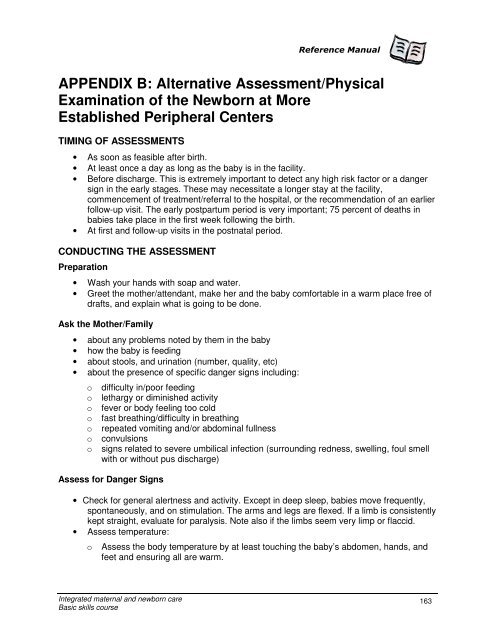Integrated Maternal and Newborn Care Basic Skills Course ...
Integrated Maternal and Newborn Care Basic Skills Course ...
Integrated Maternal and Newborn Care Basic Skills Course ...
Create successful ePaper yourself
Turn your PDF publications into a flip-book with our unique Google optimized e-Paper software.
Reference Manual<br />
APPENDIX B: Alternative Assessment/Physical<br />
Examination of the <strong>Newborn</strong> at More<br />
Established Peripheral Centers<br />
TIMING OF ASSESSMENTS<br />
• As soon as feasible after birth.<br />
• At least once a day as long as the baby is in the facility.<br />
• Before discharge. This is extremely important to detect any high risk factor or a danger<br />
sign in the early stages. These may necessitate a longer stay at the facility,<br />
commencement of treatment/referral to the hospital, or the recommendation of an earlier<br />
follow-up visit. The early postpartum period is very important; 75 percent of deaths in<br />
babies take place in the first week following the birth.<br />
• At first <strong>and</strong> follow-up visits in the postnatal period.<br />
CONDUCTING THE ASSESSMENT<br />
Preparation<br />
• Wash your h<strong>and</strong>s with soap <strong>and</strong> water.<br />
• Greet the mother/attendant, make her <strong>and</strong> the baby comfortable in a warm place free of<br />
drafts, <strong>and</strong> explain what is going to be done.<br />
Ask the Mother/Family<br />
• about any problems noted by them in the baby<br />
• how the baby is feeding<br />
• about stools, <strong>and</strong> urination (number, quality, etc)<br />
• about the presence of specific danger signs including:<br />
o difficulty in/poor feeding<br />
o lethargy or diminished activity<br />
o fever or body feeling too cold<br />
o fast breathing/difficulty in breathing<br />
o repeated vomiting <strong>and</strong>/or abdominal fullness<br />
o convulsions<br />
o signs related to severe umbilical infection (surrounding redness, swelling, foul smell<br />
with or without pus discharge)<br />
Assess for Danger Signs<br />
• Check for general alertness <strong>and</strong> activity. Except in deep sleep, babies move frequently,<br />
spontaneously, <strong>and</strong> on stimulation. The arms <strong>and</strong> legs are flexed. If a limb is consistently<br />
kept straight, evaluate for paralysis. Note also if the limbs seem very limp or flaccid.<br />
• Assess temperature:<br />
o Assess the body temperature by at least touching the baby’s abdomen, h<strong>and</strong>s, <strong>and</strong><br />
feet <strong>and</strong> ensuring all are warm.<br />
<strong>Integrated</strong> maternal <strong>and</strong> newborn care<br />
<strong>Basic</strong> skills course<br />
163

















